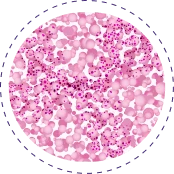Home › Mesothelioma › Types
Mesothelioma Types
There are four main types of mesothelioma, each describing the location in the body where the cancer develops and the type of cancer cells involved. Based on the primary tumor location, the types of mesothelioma are pleural, peritoneal, pericardial, and testicular. Meanwhile, the three main types of mesothelioma cells are epithelioid, sarcomatoid, and biphasic.
Last Updated:
- May 16, 2025
What Are the Four Types of Mesothelioma?
The type of mesothelioma a person is diagnosed with depends on the location of the primary tumor. The following are the four types of mesothelioma:
Pleural Mesothelioma:
forms in the lining of the chest wall and lung and makes up 70-90 percent of diagnoses annually.
Pericardial Mesothelioma:
forms in the lining of the abdomen surrounding the organ and accounts for about 10-30 percent of diagnoses annually.
Peritoneal Mesothelioma:
forms in the lining surrounding the heart, accounting for 1 percent of diagnoses annually
Testicular Mesothelioma
an extremely rare form of the disease—less than 1 percent of diagnoses, that forms in the lining of the testicles.
Treatment options for all types of mesothelioma typically include surgery, radiation therapy, chemotherapy, and immunotherapy.
Pleural Mesothelioma
The most common type of mesothelioma is pleural mesothelioma, which develops in the lining between a patient’s lung and inner chest wall. It accounts for the vast majority of mesothelioma diagnoses, ranging from 70-90 percent of cases annually.
On average, pleural mesothelioma patients survive for four to 18 months after diagnosis. Less than 10 percent of patients survive for a period of at least five years. However, there have been reports of long-term survivors with no evidence of the disease many years after their treatment.
Most patients with pleural mesothelioma first experience lung-related symptoms. Some of the main symptoms of pleural mesothelioma include the following:
- Fatigue
- Shortness of breath
- Dry cough
- Chest pain
- Rapid weight loss
- Respiratory problems
- Pneumonia
Pleural Mesothelioma Patient's Story
"I’ve been in bed for two weeks."
I just want to come home and sleep. And on the weekend, that’s all I’ve been doing is sleeping from morning until the next day.
Peritoneal Mesothelioma
Peritoneal mesothelioma is the second most common form of the disease. It develops in the lining of the abdominal cavity and accounts for about 10-30 percent of mesothelioma diagnoses. Peritoneal mesothelioma is more aggressive than other forms and typically spreads quickly from the abdomen to other body parts.
Some of the main symptoms of peritoneal mesothelioma include the following:
- Abdominal pain
- Bloating
- Swelling or fluid in the abdomen
- Nausea
- Vomiting
- Constipation
- Loss of appetite
Before any effective treatments were developed for peritoneal mesothelioma, the expected survival rate for patients was a few months to one year. However, recent advances have produced anticipated survival times ranging from one to over eight years across different clinical trials.
Pericardial Mesothelioma
Pericardial mesothelioma is a rare form of the disease that develops in the lining surrounding the heart, accounting for about 1 percent of all mesothelioma diagnoses.
Pericardial mesothelioma has very few distinct symptoms, making it difficult to diagnose. However, because the tumor is present in the lining of the heart, patients with pericardial mesothelioma generally display symptoms related to cardiac function, including the following:
- Chest pain
- Heart palpitations
- Irregular heart rhythm
- Difficulty breathing
- Shortness of breath
- Heart murmur
Testicular Mesothelioma
Testicular Mesothelioma is the rarest form, accounting for less than 1 percent of diagnoses. Because it is so rare, it is frequently misdiagnosed. This cancer develops in the lining of the testicles, and its only known symptom is testicular lumps.
Did You Know?
Most mesothelioma patients are diagnosed in their 60s or 70s—many years or decades after being exposed to asbestos. Mesothelioma is more common in men due to a higher rate of occupational asbestos exposure.
Mesothelioma Cell Types

Epithelioid
- Most Common Mesothelioma Cell
- Occurs in 60% of Cases
- Best Treatment Outcomes

Sarcomatoid
- Most Aggressive Mesothelioma Cell
- Occurs in 10-20% of Cases
- Most Difficult to Treat

Biphasic
- Mix of Both Cell Types
- Occurs in 20-30% of Cases
- Treatment Depends on Dominant Cell Type
Besides tumor location, the other factor considered when diagnosing mesothelioma is the type of cancer cells involved. Pathologists also use the cell type to classify mesothelioma tumors, some of which have better prognoses than others. The three main types of mesothelioma cancer cells include:
- Epithelioid cells – About 60 percent of mesothelioma cases involve epithelioid cells. Mesothelioma involving this cell type tends to have better treatment outcomes than the other two.
- Sarcomatoid cells – Approximately 10-20 percent of mesothelioma diagnoses involve sarcomatoid cells, which are fibrous in nature. Sarcomatous mesothelioma generally has a poor prognosis.
- Biphasic cells – The remaining cases involve biphasic tumors containing a mix of both epithelioid and sarcomatoid cells.
Free Mesothelioma Book
Since mesothelioma is a rare cancer, it can be difficult for patients to get the information they need to make informed decisions about their care. “Understanding Mesothelioma” is a free book available digitally and in print to educate mesothelioma patients and their families about the cancer. It provides an overview of mesothelioma, including its causes, diagnoses, new treatment options, caregiving information, and more. “Understanding Mesothelioma” is sponsored by Baron & Budd, P.C.

Order Your Free Mesothelioma Book

Content Reviewed by
Todd Kale
Todd Kale meets with mesothelioma patients and their families across Louisiana to investigate their asbestos exposure, providing compassionate support and guidance during a difficult time.

